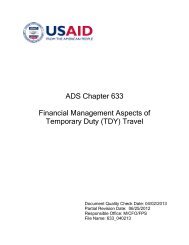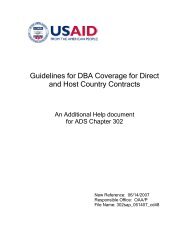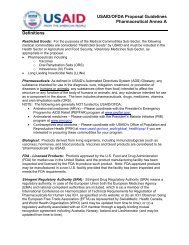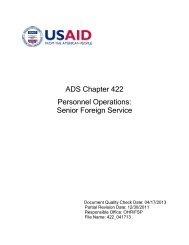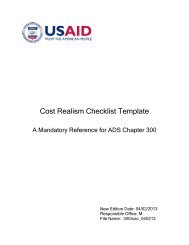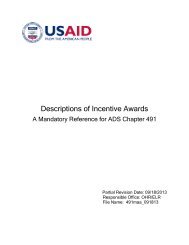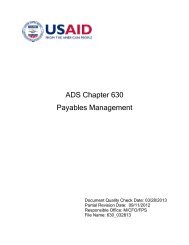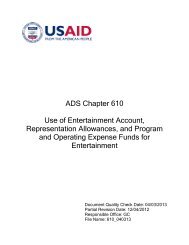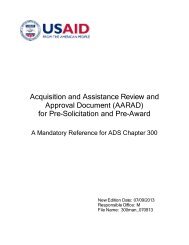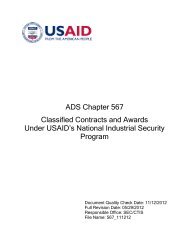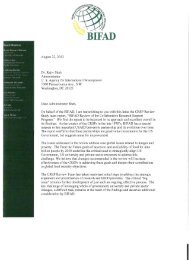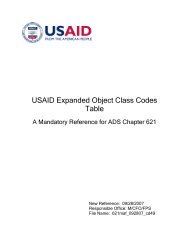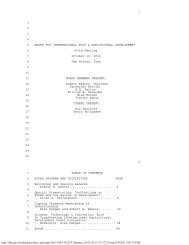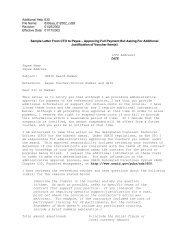USAID Policy Document - Resiliency FINAL 11-26-12.indd
USAID Policy Document - Resiliency FINAL 11-26-12.indd
USAID Policy Document - Resiliency FINAL 11-26-12.indd
- No tags were found...
You also want an ePaper? Increase the reach of your titles
YUMPU automatically turns print PDFs into web optimized ePapers that Google loves.
Executive SummaryWhile we cannot stop shocks from happening, the U.S. Agencyfor International Development (<strong>USAID</strong>) can – and must – domore to help people withstand them. <strong>USAID</strong> has been in thevanguard of international momentum to support country andregional plans and build resilience to recurrent crisis. Throughthis policy and program guidance, we will leverage the broadrange of our institutional capabilities to implement innovativeprogrammatic approaches to promote resilience. Through theseefforts, we will draw on our mandates to provide lifesaving humanitarianassistance and longer-term development assistance 1(including our Development Assistance, Global Health, andEconomic Support Funds accounts).What Is Resilience?For <strong>USAID</strong>, resilience is the ability of people, households,communities, countries, and systems to mitigate, adapt to,and recover from shocks and stresses in a manner thatreduces chronic vulnerability and facilitates inclusive growth.KEY COMPONENTS OF RESILIENCEWhile the concept of resilience has broad applicability to manyof the environments in which our Agency works, this guidanceis specifi cally focused on areas where chronic poverty intersectswith shocks and stresses to produce recurrent crises andundermine development gains. In these places, we must increaseadaptive capacity – the ability to respond quickly and effectivelyto new circumstances – and improve the ability to address andreduce risk.We will emphasize approaches that empower women andmore effectively reduce gaps between males and females.Functioning institutions of good governance and democraticaccountability are also essential; building resilient countries andsystems requires effective and inclusive governments that holdthemselves accountable for results. Working closely with otherU.S. Government agencies, international donors, multilateralorganizations, and other partners, we will elevate and supportinclusive country-led plans that lead to sustainable reductions invulnerability and promote inclusive growth.AN AGENDA FOR OPERATIONAL CHANGEOur success in achieving these goals requires that we establishresilience to recurrent crisis as a common objective across ourdevelopment and humanitarian programs. While we will maintainboth the lifesaving speed of humanitarian assistance andthe longer-term focus of development assistance, we will alsoidentify opportunities to layer, integrate, and sequence these corecapabilities to achieve results.THE RESULTS WE SEEKOur efforts to build resilience will contribute to a sustainable reduction in vulnerability and more inclusive growth. Inthis pursuit and in the areas where we apply this policy and program guidance, we intend that our efforts will result in:• increased adaptive capacity• improved ability to address and reduce risk• improved social and economic conditions of vulnerable populationsOver the long-term, we envision that these results will collectively contribute to reduced humanitarian need, and metricswill be developed to capture these results.Ultimately, we seek to save and improve lives. In the Horn of Africa, for example, we aim to benefi t directly 10 millionpeople and reduce the region’s emergency caseload by 1 million people within 5 years. We are defi ning a comparableexpectation for impact in the Sahel, based on local conditions, and will likewise develop metrics for impact in otherfocus countries and regions moving forward.1 For the purposes of this guidance, the term “development assistance” refers to funding in our Development Assistance, Global Health, and Economic Support Fundsaccounts.5



